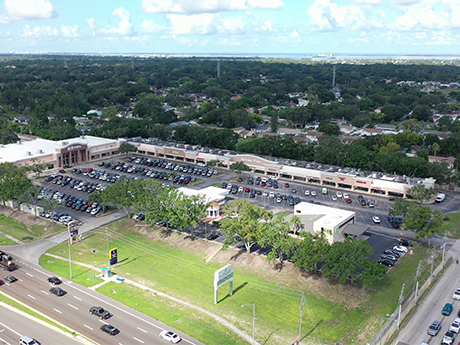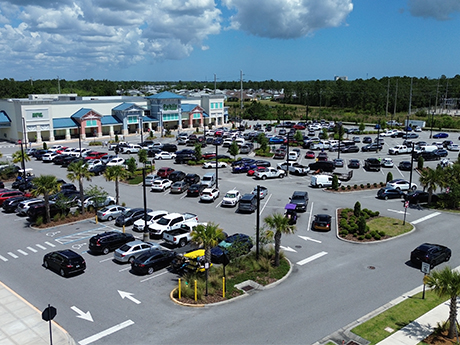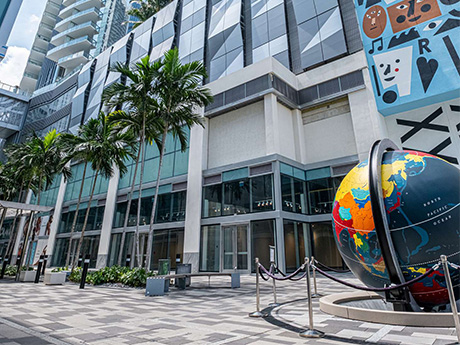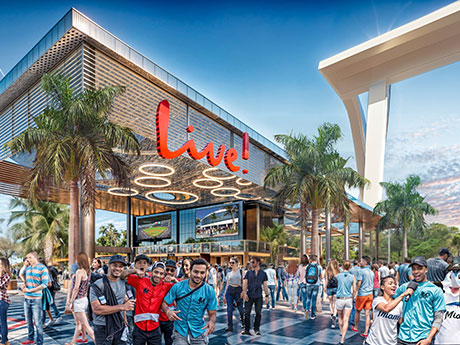When asked what makes Florida appealing from a retail perspective, Steven Miskew, CEO of Southeast Centers, put it succinctly: “The good macro-economic drivers are here: population growth, lack of supply and low vacancy, all in a pro-business environment,” he said.
As Miskew asserts, Florida’s population continues to swell as approximately 1,755 people move into the state daily, according to 2023 data from online self-storage platform StorageCafe.
Additionally, U-Haul has ranked Florida as a top four growth state in its annual growth index — which analyzes the destinations for one-way moves across its fleet — every year since 2015. Seven Florida cities ranked in U-Haul’s top 25 growth metros in 2024.

Florida’s growing population underpins the success of its retail sector as more rooftops directly correlates to more demand for corresponding services, including grocery, food-and-beverage, health and wellness and soft goods.
Phil Kirkpatrick, business recruitment and property development at the City of Clearwater’s economic development and housing department, says that the Tampa Bay-area city is seeing very strong retail occupancy levels.
“Vacancy is quite low as of the end of 2024, sitting at 5.4 percent,” says Kirkpatrick, acknowledging that the rate exceeds the vacancy rate of the overall Tampa Bay metro area of 3.5 percent, according to data from
Cushman & Wakefield.
Miami is among the tightest retail markets in the state at 3.1 percent as of second-quarter 2025, according to data from Colliers. Jeremy Larkin, CEO of NAI Miami | Fort Lauderdale, says that’s because the South Florida region, which mainly comprises the tri-county area of Palm Beach, Broward and Miami-Dade counties, is experiencing the bulk of the population influx.
“Sixty to 70 percent of the newcomers move to South Florida,” says Larkin. “The math is pretty good, and they are generally affluent.”
Scott Renick, vice president of commercial development at The Villages master-planned community in Central Florida, says that the 60,000-acre development’s retail component has been operating at close to 98 percent occupancy for years.
Southeast Centers operates more than 4 million square feet of retail space in Florida. Miskew says that managing 45 grocery-anchored shopping centers across the state has highlighted how tight Florida’s metros are when it comes to retail occupancy opportunities.
“We have strong demand, but we are still under-supplied from a retail standpoint,” says Miskew.
Because of the robust demand for available retail space, landlords have been able to push rental rates at both ground-up developments and second-generation space. Renick says that rising rental rates go beyond supply/demand dynamics.
“We are having to push rents on new construction projects due to the current cost environment,” says Renick. “That said, we’ve still been able to get deals done.”
Navigating storm clouds
Sources interviewed for the story acknowledged that despite the national narrative about tariff-related pricing increases, costs have been reigned in from the volatility of past years, especially during the supply chain complications arising during the COVID era. The producer price index (PPI) for construction materials rose a little more than 3 percent from June 2024 to June 2025, according to data from the U.S. Bureau of Labor Statistics.
“We’re in a period of cost predictability,” says Josh Beyer, senior vice president of development at Sembler. “We access real-time information through our industry partnerships, enabling us to make informed and agile decisions.”
“In the past three or four months we’ve seen a flattening or slight decline of construction materials costs,” adds Joseph Beninati, founder of Double B Development. “We’re not seeing inflationary effects; the tariff story seems to be a dog that didn’t bark.”
One cost input that developers and owners are monitoring closely is rising insurance premiums due to Florida’s history of hurricane-related damages and reduced capacity among insurance providers, with some providers exiting the state altogether in recent years or halting new business in the state.

“Insurance premiums come with the territory as a Florida-based developer,” says Zachary Hammer, vice president of leasing and development at Sutton Properties. “While construction costs and insurance premiums fluctuate — and they’re high right now — the strength of our real estate carries us through most obstacles, as our portfolio is strategically positioned in high-growth markets.”
Beninati notes that his firm has actually seen a reduction of insurance-related costs recently.
Property owners are hoping that they’ll be able to offset some of the higher costs in capital expenditures, including for land and labor, with a reduction in taxes. Specifically, beginning in October the State of Florida will eliminate sales taxes on commercial real estate leases, including for shops and restaurants. Florida Gov. Ron DeSantis signed the new law, Florida House Bill 7031, into law on June 30.
While new legislation is helping property owners in this instance, some government regulations have caused prices and development timelines to expand. Multiple sources have stated that changes for grease traps by Miami-Dade County’s Department of Environmental Resources Management (DERM) have been a thorn in the side for retail landlords, developers, owner/users or tenants who acquire or lease second-generation restaurant space.
“DERM changed the grease trap regulations about five years ago,” says Larkin. “What was once grandfathered in is no longer grandfathered in. Grease traps that aren’t up to current code have to be replaced, and that’s not cheap. At the same time, food and labor costs have gone through the roof.”
Developments taking shape
New construction for retail has undoubtedly cooled off in recent years due to higher costs, including for new construction financing. Yet there are still massive developments underway or coming on line across the state. These include the recently opened, $6 billion Miami Worldcenter project by CIM Group and Miami Worldcenter Associates; the $1 billion NORA District project in downtown West Palm Beach by NDT Development, Place Projects and Wheelock Street Capital; Westcourt Orlando, a 900,000-square-foot mixed-use development near the Orlando Magic’s home arena that will include a 3,500-seat Live Nation venue; and Pearl Square, a $2 billion mixed-use development in downtown Jacksonville by Gateway Jax that will add more than 200,000 square feet of retail and restaurant space upon full build-out.

Additionally, The Cordish Companies has a pair of mixed-use entertainment districts that are getting finishing touches: The Pomp, a 223-acre development in Pompano Beach anchored by Harrah’s Pompano Beach casino and Topgolf, and Miami Live!, a year-round retail and entertainment district at loanDepot Park, the home ballpark of the Miami Marlins MLB team. Cordish is partnering with Caesar’s Entertainment and the Marlins on the projects, respectively.
“The Pomp represents one of the most dynamic opportunities for placemaking in Florida. The 8 million-square-foot Pomp project is well under construction, with Topgolf and Harrah’s Pompano Beach Casino already open,”says Cari Furman, vice president of communications for Cordish.“Our latest sports-anchored project with the Miami Marlins will create a vibrant year-round destination for loanDepot park, and we are honored to have been selected by them as their development partner to deliver this dynamic vision.”
In Central Florida, Double B Development is preparing to cut the ribbon on the roads and utility infrastructure at Wyld Oaks, a 255-acre mixed-use development located at State Road 429 and West Kelly Park Road in Apopka, a city in Orange County.
“When master developers talk about having ‘shovel-ready’ projects, it’s a very gray definition,” says Beninati. “We genuinely have sidewalks, curbs and utilities in place subbed to all the parcels such that a user can leverage all of our entitlements and go vertical immediately.”
Beninati says that one of the next steps is breaking ground on a four-lane road within the campus in October and to announce its new wellness partner for the development. The developer recently announced that Onx Homes will be developing single-family homes at Wyld Oaks and that SBA Communications will be providing fiber connectivity infrastructure throughout the development.
The Wyld Oaks development will begin welcoming residents and retailers in the next 12 to 18 months, according to Beninati. In addition to residences, shops and restaurants, the development will feature a seven-acre park called Yonder with groves of 150-year-old oak trees, as well as The BARK dog park. Beninati says that having this open space is crucial to the feel and vibrancy the developer wants to cultivate at Wyld Oaks.
“The conceit is that the folks who are going to work and live in the development will be able to access Yonder on a regular basis,” says Beninati. “It will be a reprieve from all of our busy schedules and a way to detach and think or just chill out.”
In Daytona Beach, Sutton is seeking out a junior anchor for Phase II of Latitude Landings, which the company recently began preleasing. Phase I is approximately 95 percent leased and is anchored by Publix.
Hammer says that Margaritaville recently sold all of its 3,900-plus homes within its Latitude Margaritaville master plan. He adds that the presence of those residents is driving much of the demand at Latitude Landings.
“Margaritaville residents drive their golf carts in and out of Phase I of our development,” says Hammer. “We believe that we have the dominant positioning in the submarket west of I-95 on LPGA Boulevard. When all is said and done, between the in-line space and outparcels at Latitude Landings, we expect to operate 200,000 square feet of gross leasable area.”
The Villages has five mixed-use lifestyle centers and 15 developments with a grocery component, according to Renick. All told, The Villages spans 7.5 million square feet of commercial real estate space, with more on the way.
“Middleton is our most recent mixed-use center that is surrounded by our second charter school campus and a family housing area we are developing,” says Renick, noting that Portillo’s is opening in Middleton. “Eastport is another mixed-use project that we are completing this year and plan to have a large number of tenant openings as we get into the first half of 2026. We have more grocery-anchored and lifestyle retail projects currently in the planning stages that we will open as the residential areas fill in.”
While Florida is not lacking for blockbuster developments, the meat of new development is concentrated within traditional grocery-anchored and unanchored retail centers around the state.
Sembler is putting the finishing touches on Daniels Crossing, a shopping center redevelopment in Fort Myers that the firm is co-developing with Forge Capital Partners. Publix plans to reopen its store at the development in September, alongside a 3,010-square-foot Publix Liquor store. Sembler also performed façade and common area enhancements at the development during the redevelopment phase. Other tenants at the property include Duck Donuts, Millenium Physician Group, Potts Sport Café, Quest Diagnostics, School of Rock, Subway, Sugaring NYC and The UPS Store.
Redevelopments play a crucial part in the retail growth story of Florida. Cities like Clearwater are partnering with private developers to redevelop blighted properties in order to elevate the retail offerings in a given market.
“The City of Clearwater is actively seeking developers to redevelop several shopping centers along U.S. Highway 19 and in the downtown area,” says Kirkpatrick. “The location of the downtown redevelopment opportunity [could create] an iconic gateway for both those entering Clearwater Beach and those returning to the mainland. It could be the most impactful real estate in all of Florida.”

On the ground-up front, Sembler has assembled two sites in east Fort Myers spanning 40 acres each. At those sites, the developer is planning two new shopping centers: Gateway Marketplace and Creekside Marketplace.
“The projects will include grocery and multiple large-format national retailers, restaurants and service retailers, as well as significant medical user,” says Beyer.
Beyer says that Sembler’s concentration on the east side of Lee County, where Gateway Marketplace and Creekside Marketplace will sit, is where the wave of residential growth is occurring in the region.
“That part of Lee County is the last area with large tracts of land in the greater Fort Myers region for homebuilders to develop master-planned communities,” says Beyer. “Lehigh Acres proper has tens of thousands of vacant lots with the infrastructure in place, more than 4,000 residential permits have been issued in Lehigh Acres annually for several years now. The demand from retailers is significant as they see the opportunity to serve this established and rapidly growing market Gateway Marketplace and Creekside Marketplace ideally positioned in the market.”
Sembler also acquired land in nearby Port Charlotte, with expectations to start construction this year on Westport Marketplace, a Publix-anchored shopping center. Together with Gateway Marketplace and Creekside Marketplace, the three shopping centers will span more than 600,000 square feet.
Leasing philosophies
In 2023, brothers Jonathan and Abraham Fish opened Thrive Arts District, a 5.3-acre mixed-use development in Fort Lauderdale that features artist studios, offices, stores, restaurants and 17,000 square feet of outdoor space for events. Locally based Native Realty took over the leasing assignment at Thrive Arts District in late 2024 and has since signed 11 tenants, boosting the occupancy at the development to 75 percent.
“We have really transformed that space, we were the third broker to take that assignment,” says Kaley Tuning, chief operating officer for Native Realty. “The Fisher brothers are hyper-focused on art at the development. They want to create a really cool, approachable atmosphere akin to Wynwood in Miami.”
The newest retailers to join the tenant roster at Thrive Arts District include Sweet Leaf Body Art, Greek Sugar, Frandoge, Petrol Head Motor Co. and Her Haus Studios.
“We’ve signed 11 leases, but we’ve probably had about 35 offers, we’re just very selective,” says Tuning. “Ownership wants the right tenant mix that’s going to create a good co-tenancy and work together to bring in traffic.”
Tuning says that bucking the trend of leasing to national brands has helped differentiate the development from its counterparts. Her Haus is led by two women who will operate a creative office space with content creation space and a podcast studio. Frandoge is a wine bar and eatery, and Petrol Head Motor Co. began as a passion project for a collector of vintage motorcycles that led to an elevated showroom with motorcycle-related apparel.
“There are some very cool, unique mom-and-pop type tenants that we truly believe in and that we know will do good for the community and help shape the neighborhood,” says Tuning. “The bread and butter for the curation of our neighborhoods is on the tenant side, though some in our team are hyper-focused on development.”
Beninati says that Double B is taking a similar approach at Wyld Oaks.
“The tiebreaker will always go to a local or Florida-based company,” says Beninati. “We do not want people who are traveling from out of town to get the feeling like they could be any vanilla mixed-use community in the United States. We’re aiming to mix in as many local-, regional- and state-based brands as we can at Wyld Oaks.”
Sources say that national concepts are still leasing space in full force. At The Villages, Costco, Walmart, Portillo’s, Chase Bank and Mavis Tires & Brakes have struck deals recently for new stores.
Sutton recently opened a 51,000-square-foot Crunch Fitness on US-19 North in Palm Harbor, backfilling LA Fitness as the anchor at Alderman Plaza.
“It is a new Crunch 3.0 prototype; it’s a state-of-the-art facility,” says Hammer. “ Crunch Fitness had a very productive grand opening.”
Along the famed Lincoln Road in Miami Beach, Victoria’s Secret and PINK have recently relocated to a newly built-out space spanning 7,500 square feet at 900-904 Lincoln Road, and Beverly Hills-based Alo Yoga will open a new flagship spanning 13,480 square feet at 100 Lincoln Road, a space that has been vacant for a few years.
Lyle Stern, partner at Vertical Real Estate, property owner on Lincoln Road and president of the Lincoln Road BID, says the BID oversees the programming and activations at Lincoln Road, as well as working with the City of Miami Beach on tasks like sanitation and security. Stern says that as the retail high street of Miami Beach, Lincoln Road has to be all things to all visitors and locals.
“There’s nothing you can’t buy online, so how do we make shopping on Lincoln Road interesting?” asks Stern. “Visitors want the dining and shopping experience with great landscaping, easy parking, great cultural programming and the sense of being part of a community. They want to be somewhere that is safe and interesting.”
The Lincoln Road BID recently announced a new wave of retailers and restaurants to join the high street. The new concepts include All’Antico Vinaio, an Italian sandwich concept that will occupy 1,793 square feet at 647 Lincoln Road; Ché by Chelsey, an apparel concept that opened its 675-square-foot boutique at 830 Lincoln Road in May; and Davinci Gelato, which opened its 1,350-square-foot gelato shop at 645 Lincoln Road in May.

Other newcomers will include Prince Street Pizza and Negroni Caffe & Sushi Bar, which will open before the end of the year, as well as Noble 33’s Mediterranean dining concept Meduza Mediterrania, which will open in 2026.
“When you look at the investments surrounding Lincoln Road, it shouldn’t be much of a surprise to anyone that there’s demand by both new restaurants and new retailers to land here,” says Stern, referring to the $4 billion in investment at the nearby Billionaire’s Row district. “Lincoln Road continues to be one of those streets in the country, and certainly in South Florida, where the tenants have voted with leases, that this is a place that they want to lean into and have a home in.”
— By John Nelson. This article was originally published in the August issues of Shopping Center Business and Southeast Real Estate Business.


